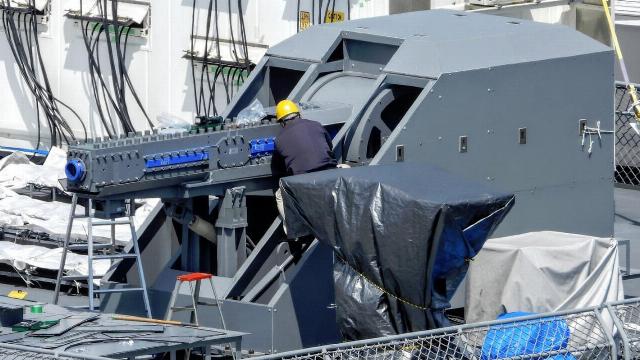Japan's self-Defense forces continue to work on an electromagnetic railgun (railgun). The latest confirmation of this was the photos published by the Japanese Navy from aboard the JS Asuka test warship in the port of Yokosuka. It is expected that tests of these weapons in this configuration will take place before the end of July 2025. Japan's ongoing developments in this area stand in stark contrast to the US Navy's abandonment of this category of weapons in the early 2020s after serious technical problems arose.
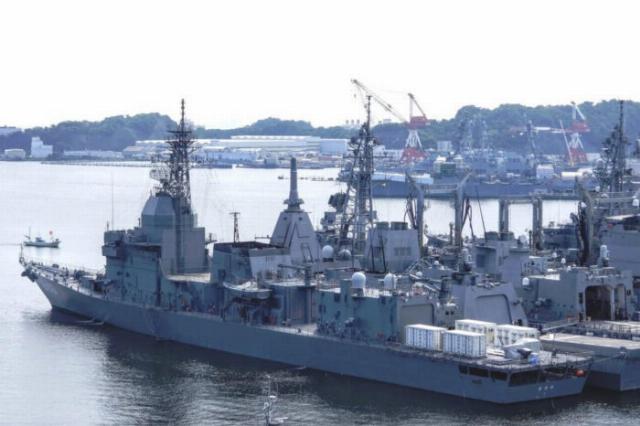
Ship JS "Asuka" in the port of Yokosuka with a rail gun (here it is closed) on the aft flight deck.
According to experts, according to the photos, the railgun installed in the tower at Asuka is very similar, if not identical, to the prototype that the Agency for Procurement, Technology and Logistics of the Ministry of Defense of Japan (ATLA) has been testing on land and at sea for several years.
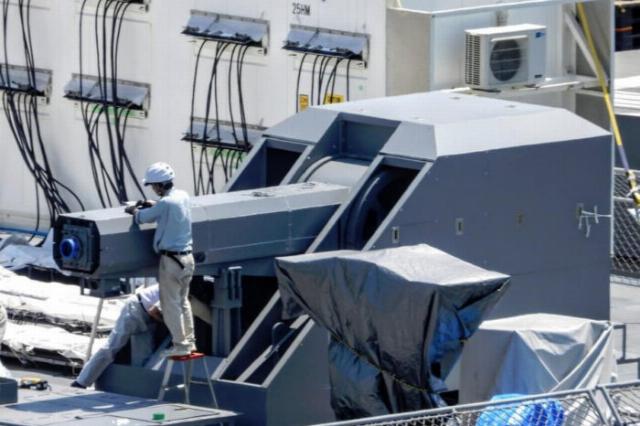
A gun turret with a casing around a rail cannon
The images also show several containers with generators and/or capacitors, as well as other shipping containers that may contain additional systems or workstations. Railguns, which use electromagnets instead of chemical fuel to fire projectiles at very high speeds, have historically required significant power generation and cooling. Due to these requirements, full-fledged railguns are usually very bulky.
Considering all this, it is noted that the installation of a railgun on the Asuka flight deck makes sense from the point of view of testing, due to the large open spaces. For the traditional integration of such weapons onto an active warship, it is necessary to provide power and cooling, as well as find enough space below deck for various components, not to mention the time and resources needed for larger-scale modifications.
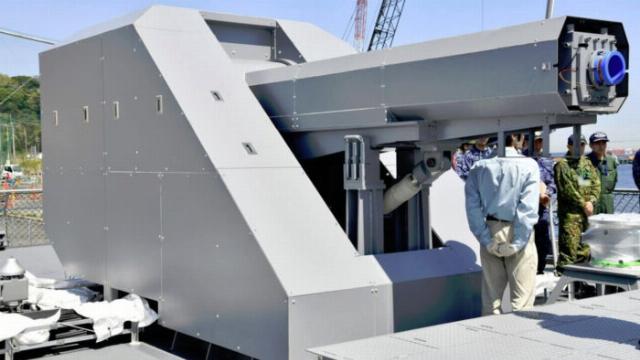
A rail gun on board the JS Asuka. Photo of the Naval Self-Defense Forces of Japan. April 2025.
Railguns create additional problems related to wear during prolonged firing of projectiles at very high speeds. Due to the strong friction, the barrels wear out quickly, which leads to a decrease in range and accuracy of fire, as well as the potential risk of catastrophic failure.
According to ATLA data, during previous tests, a Japanese-designed railgun demonstrated the ability to fire projectiles at a speed of about 2,230 m/sec. (6.5 Mach) when using 5 MJ of charge energy. As of April 2025, previous test targets included achieving a projectile muzzle velocity of at least 2,000 m/s and a barrel life of 120 rounds. Reports say that ATLA is also working to reduce the energy consumption of weapons.
Speaking at a panel discussion at DSEI Japan 2025, Kazumi Ito, chief director of the Equipment policy Department at ATLA, said that the development of the railgun in Japan is "going according to plan," but acknowledged the presence of "various problems."
Despite the difficulties, the Japanese authorities have made it clear that they plan to create an operational marine rail gun in the future. Since the DSEI Japan 2025 exhibition in early 2025, the Ministry of Defense of Japan has publicly demonstrated a model of a rail cannon in a turret with a much more streamlined design than the one installed on the Asuka.
At a public presentation in 2024, Vice Admiral of the Japanese Navy Imayoshi Shinichi, ATLA's Director General for Naval Systems, also spoke about plans to install a railgun on future Type 13DDX destroyers, which were scheduled to enter service in 2024. Earlier, ATLA presented an artistic concept of the Maya project destroyer armed with a railgun, also known as 27DDG.
ATLA's plans, which were announced in 2024, also include land-based railguns mounted on trucks. According to experts, "in principle, a practical electromagnetic railgun could become a highly efficient and flexible weapon system capable of quickly hitting a wide range of targets at sea, on land, and even in the air at considerable distances. Japan has previously expressed interest in this capability to protect itself from approaching hypersonic threats. Such a weapon would also be advantageous in terms of the number of rounds in the ammunition package and cost compared to traditional surface—to—air and surface-to-surface missiles, given the small size and low price per unit of individual projectiles."
Japan is not the only country trying to bring the railgun's capabilities to life. Over the past 20 years, the US Armed Forces have been experimenting with railgun designs. The US Navy was particularly active in this area from 2005 to 2022, but eventually stopped this work due to constant technical problems. The planned tests at sea were never carried out due to constant delays. Interestingly, according to reports, ATLA employees met with representatives of the US Navy about the possible use of their developments in the field of railguns.
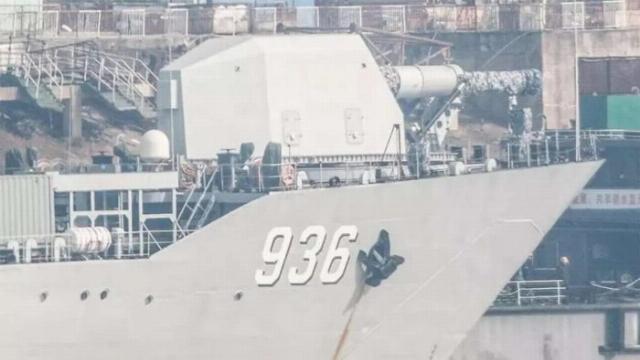
PLA Navy Rail Cannon, 2018
China, as Japan's main competitor regionally and globally, is also actively developing shipboard railguns. The railgun in the turret first appeared on a PLA Navy ship back in 2018. It is unknown how the development of this or other Chinese railguns has progressed since then.
Other countries are also actively developing railguns. First of all, Turkey, including for use in the navy. In 2024, the Japanese authorities themselves signed an agreement on cooperation in the development of railguns with colleagues from France and Germany.
According to the materials of the resource twz.com
